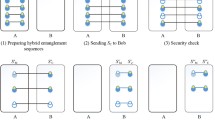Abstract
Quantum teleportation of an unknown quantum state is one of the few communication tasks which has no classical counterpart. Usually the aim of teleportation is to send an unknown quantum state to a receiver. But is it possible in some way that the receiver’s state has more quantum discord than the sender’s state? We look at a scenario where Alice and Bob share a pure quantum state and Alice has an unknown quantum state. She performs joint measurement on her qubits and channel to prepare Bob’s qubits in a mixed state which has higher quantum discord than hers. We also observe an interesting feature in this scenario, when the quantum discord of Alice’s qubits increases, then the quantum discord of Bob’s prepared qubits decreases. Furthermore, we show that the fidelity of one-qubit quantum teleportation using Bob’s prepared qubits as the channel is higher than using Alice’s qubits.






Similar content being viewed by others
References
Bennett, C.H., Brassard, G., Crépeau, C., Jozsa, R., Peres, A., Wootters, W.K.: Teleporting an unknown quantum state via dual classical and Einstein–Podolsky–Rosen channels. Phys. Rev. Lett. 70, 1895–1899 (1993)
Dakić, B.: Quantum discord as resource for remote state preparation. Nat. Phys. 8, 666–670 (2012)
Horodecki, P., Tuziemski, J., Mazurek, P., Horodecki, R.: Can communication power of separable correlations exceed that of entanglement resource? Phys. Rev. Lett. 112, 140507 (2014)
Micuda, Michal, Starek, Robert, Marek, Petr, Mikova, Martina, Straka, Ivo, Jezek, Miroslav, Tashima, Toshiyuki, Ozdemir, Sahin K., Tame, Mark: Experimental characterization of a non-local convertor for quantum photonic networks. Opt. Express 25, 7839–7848 (2017)
Tashima, T., Tame, M.S., Ozdemir, S.K., Nori, F., Koashi, M., Weinfurter, H.: Photonic multipartite entanglement conversion using nonlocal operations. Phys. Rev. A 94, 052309 (2016)
Oppenheim, J., Horodecki, M., Horodecki, P., Horodecki, R.: Thermodynamical approach to quantifying quantum correlations. Phys. Rev. Lett. 89, 180402 (2002)
Ferraro, A., Paris, M.G.A.: Nonclassicality criteria from phase-space representations and information-theoretical constraints are maximally inequivalent. Phys. Rev. Lett. 108, 206403 (2012)
Agudelo, E., Sperling, J., Vogelr, W.: Quasiprobabilities for multipartite quantum correlations of light. Phys. Rev. A 87, 033811 (2013)
Gheorghiu, Vlad, de Oliveira, Marcos C., Sanders, Barry C.: Nonzero classical discord. Phys. Rev. Lett. 115, 030403 (2015)
Ollivier, H., Zurek, W.H.: Quantum discord: a measure of the quantumness of correlations. Phys. Rev. Lett. 88, 017901 (2001)
Henderson, L., Vedral, V.: Classical, quantum and total correlations. J. Phys. A Math. Gen. 34, 6899 (2001)
Datta, A., Shaji, A., Caves, C.M.: Quantum discord and the power of one qubit. Phys. Rev. Lett 100, 050502 (2008)
Adesso, G., Bromley, T.R., Cianciaruso, M.: Measures and applications of quantum correlations. J. Phys. A Math. Theor. 49, 473001 (2016)
Streltsov, A.: Quantum Correlations Beyond Entanglement and Their Role in Quantum Information Theory, pp. 2191–5423. Springer, Berlin (2015)
Girolami, D., Adesso, G.: Quantum discord for general two-qubit states: analytical progress. Phys. Rev. A 83, 052108 (2011)
Ozdemir, S.K., Bartkiewicz, K., Liu, Y-x, Miranowicz, A.: Teleportation of qubit states through dissipative channels: conditions for surpassing the no-cloning limit. Phys. Rev. A 76, 042325 (2007)
Bartkiewicz, K., Miranowicz, A., Ozdemir, S.K.: Optimal mirror phase-covariant cloning. Phys. Rev. A 80, 032306 (2009)
Julia-Díaz, B., Burdis, J.M., Tabakin, F.: QDENSITY-A mathematica quantum computer simulation. Comp. Phys. Commun. 180, 474 (2009)
Verstraete, F., Verschelde, H.: Optimal teleportation with a mixed state of two qubits. Phys. Rev. Lett. 90, 097901 (2003)
Vidal, G., Werner, R.F.: Computable measure of entanglement. Phys. Rev. A 65, 032314 (2002)
Wootters, W.K.: Entanglement of formation of an arbitrary state of two qubits. Phys. Rev. Lett. 80, 2245–2248 (1998)
Acknowledgements
We would like to thank Satyabrata Adhikari and Prasanta Kumar Panigrahi for useful discussions.
Author information
Authors and Affiliations
Corresponding author
Rights and permissions
About this article
Cite this article
Sarkar, S., Datta, C. Can quantum discord increase in a quantum communication task?. Quantum Inf Process 17, 248 (2018). https://doi.org/10.1007/s11128-018-2019-2
Received:
Accepted:
Published:
DOI: https://doi.org/10.1007/s11128-018-2019-2




